check engine FORD CONTOUR 1998 2.G Owner's Manual
[x] Cancel search | Manufacturer: FORD, Model Year: 1998, Model line: CONTOUR, Model: FORD CONTOUR 1998 2.GPages: 200, PDF Size: 2.7 MB
Page 79 of 200
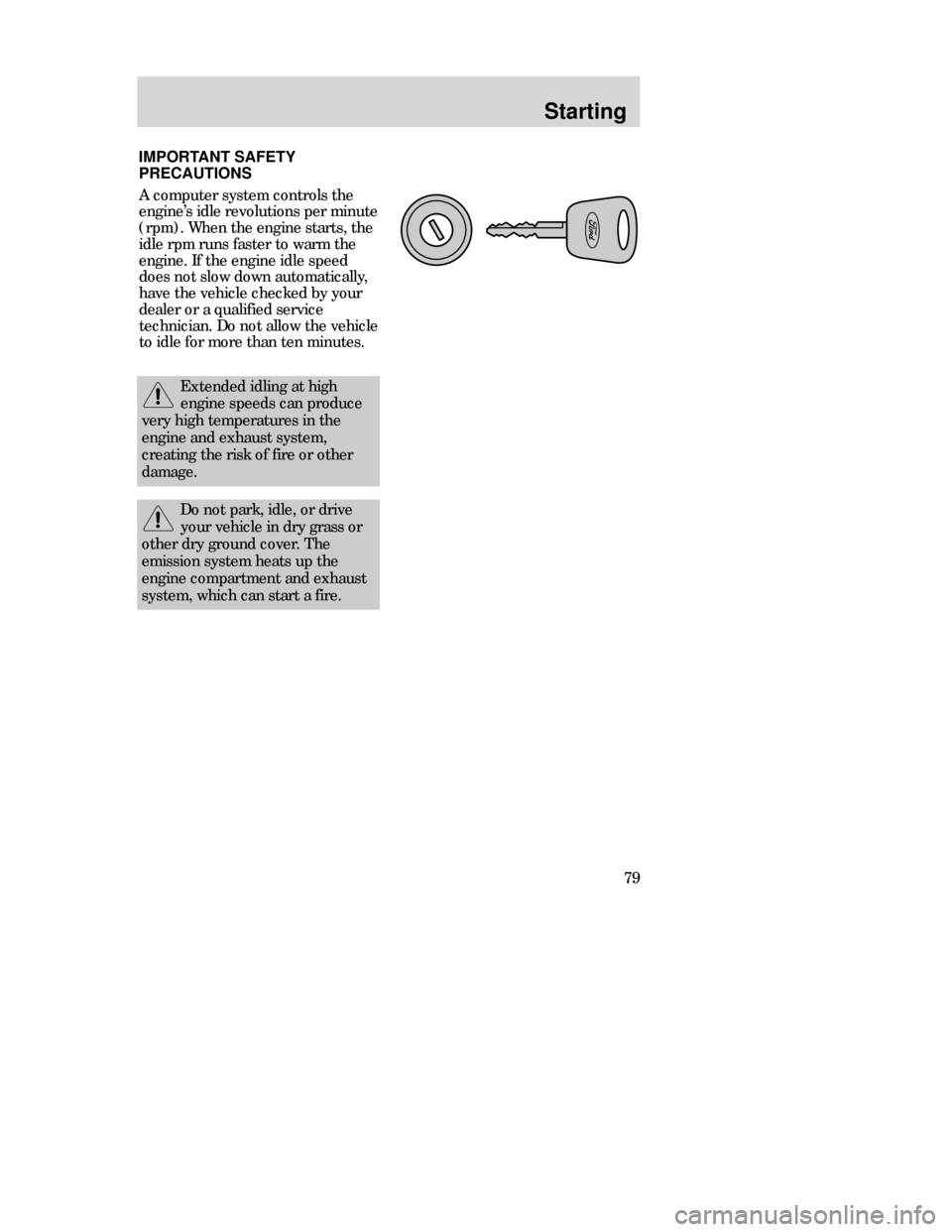
79
Starting
Extended idling at high
engine speeds can produce
very high temperatures in the
engine and exhaust system,
creating the risk of fire or other
damage.
IMPORTANT SAFETY
PRECAUTIONS
A computer system controls the
engine’s idle revolutions per minute
(rpm). When the engine starts, the
idle rpm runs faster to warm the
engine. If the engine idle speed
does not slow down automatically,
have the vehicle checked by your
dealer or a qualified service
technician. Do not allow the vehicle
to idle for more than ten minutes.
Do not park, idle, or drive
your vehicle in dry grass or
other dry ground cover. The
emission system heats up the
engine compartment and exhaust
system, which can start a fire.
CDW IIID Seat en C 5/15/97 8:48 PM Page 79
Page 84 of 200
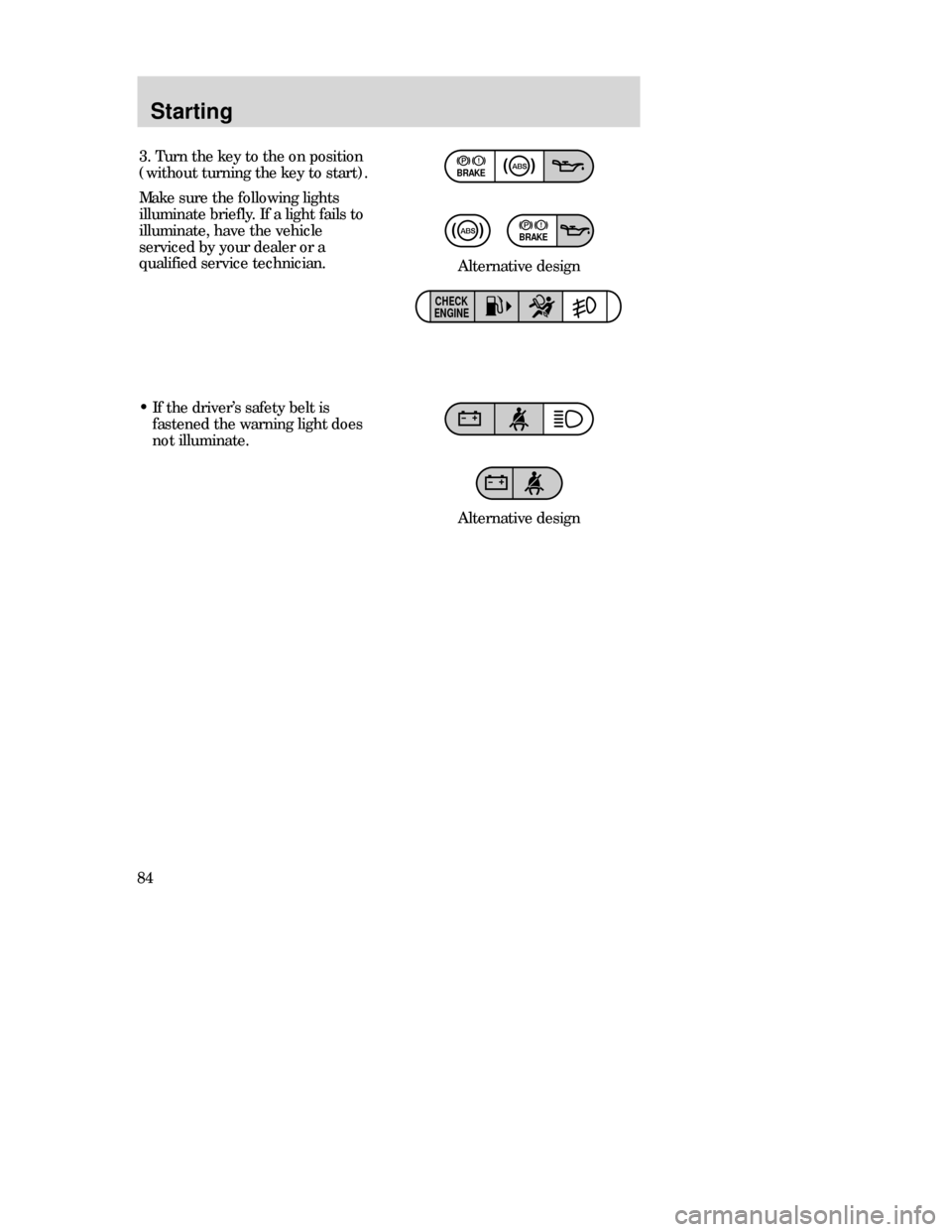
Starting
843. Turn the key to the onposition
(without turning the key to start).
Make sure the following lights
illuminate briefly. If a light fails to
illuminate, have the vehicle
serviced by your dealer or a
qualified service technician.
BRAKE
BRAKE
CHECK
ENGINE
•If the driver’s safety belt is
fastened the warning light does
not illuminate.Alternative design
Alternative design
CDW IVA1_2 Starting en C 5/15/97 8:50 PM Page 84
Page 111 of 200
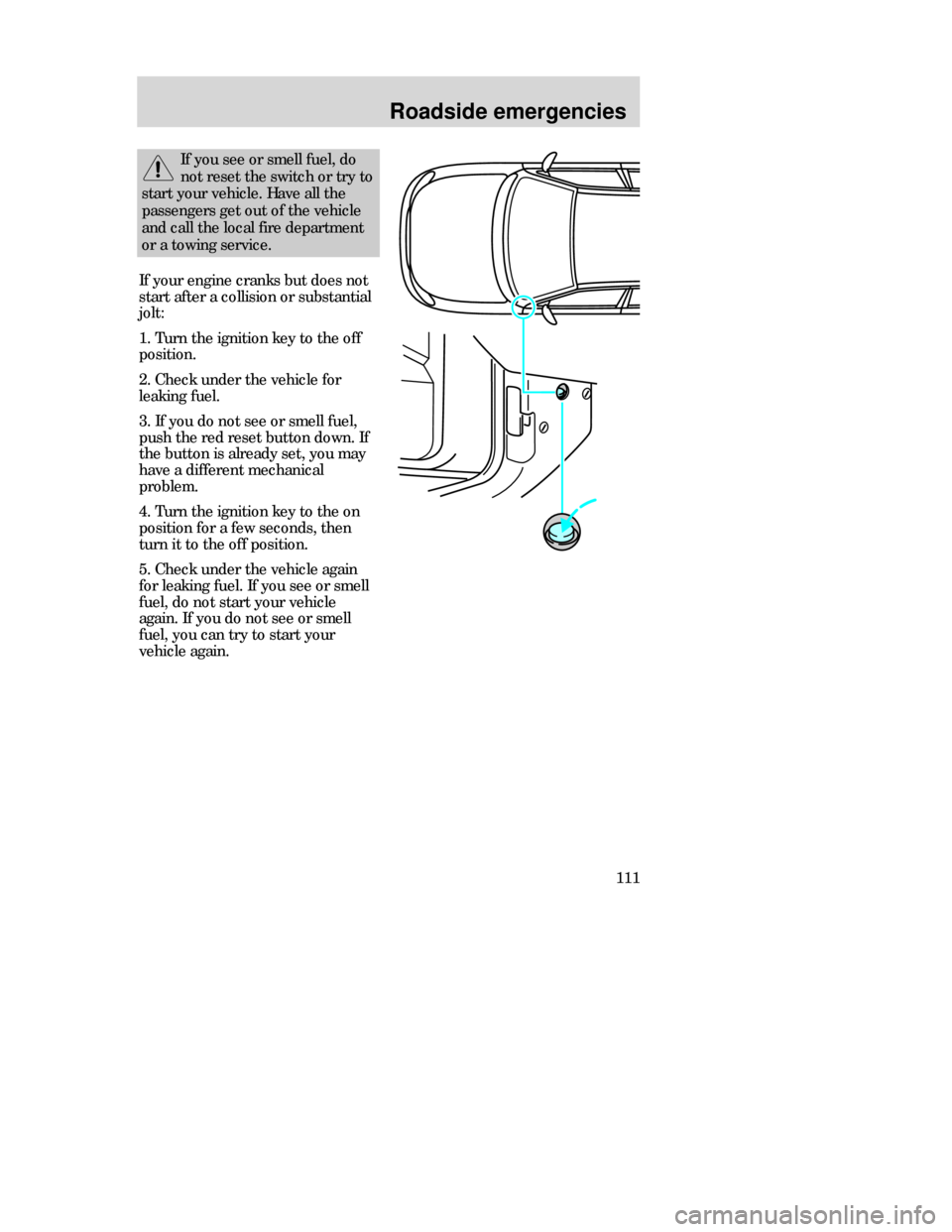
Roadside emergencies
111
If your engine cranks but does not
start after a collision or substantial
jolt:
1. Turn the ignition key to the off
position.
2. Check under the vehicle for
leaking fuel.
3. If you do not see or smell fuel,
push the red reset button down. If
the button is already set, you may
have a different mechanical
problem.
4. Turn the ignition key to the on
position for a few seconds, then
turn it to the off position.
5. Check under the vehicle again
for leaking fuel. If you see or smell
fuel, do not start your vehicle
again. If you do not see or smell
fuel, you can try to start your
vehicle again.
If you see or smell fuel, do
not reset the switch or try to
start your vehicle. Have all the
passengers get out of the vehicle
and call the local fire department
or a towing service.
CDW IVC1-6Roads en C 5/15/97 8:53 PM Page 111
Page 112 of 200
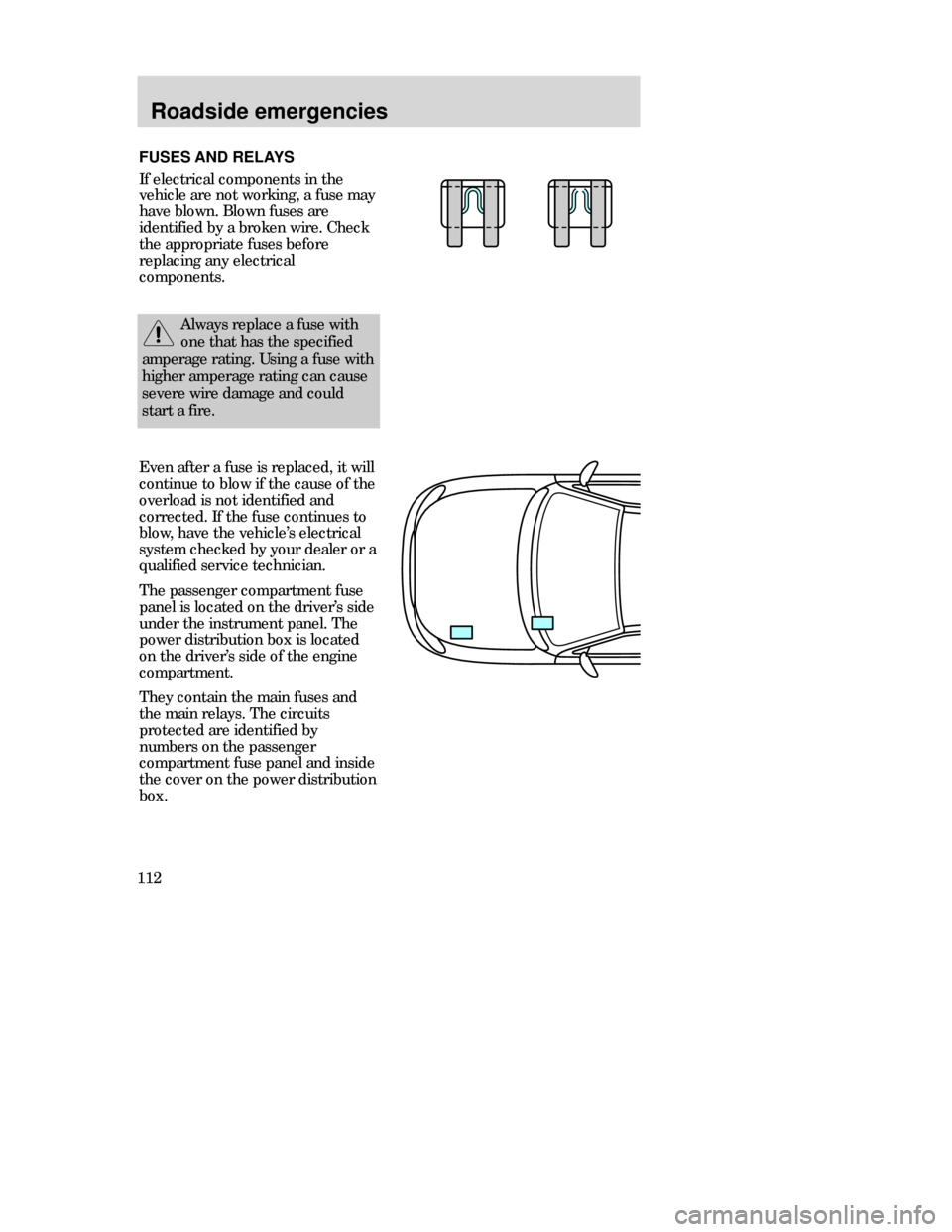
Even after a fuse is replaced, it will
continue to blow if the cause of the
overload is not identified and
corrected. If the fuse continues to
blow, have the vehicle’s electrical
system checked by your dealer or a
qualified service technician.
The passenger compartment fuse
panel is located on the driver’s side
under the instrument panel. The
power distribution box is located
on the driver’s side of the engine
compartment.
They contain the main fuses and
the main relays. The circuits
protected are identified by
numbers on the passenger
compartment fuse panel and inside
the cover on the power distribution
box.
Roadside emergencies
112
FUSES AND RELAYS
If electrical components in the
vehicle are not working, a fuse may
have blown. Blown fuses are
identified by a broken wire. Check
the appropriate fuses before
replacing any electrical
components.
Always replace a fuse with
one that has the specified
amperage rating. Using a fuse with
higher amperage rating can cause
severe wire damage and could
start a fire.
CDW IVC1-6Roads en C 5/15/97 8:53 PM Page 112
Page 113 of 200
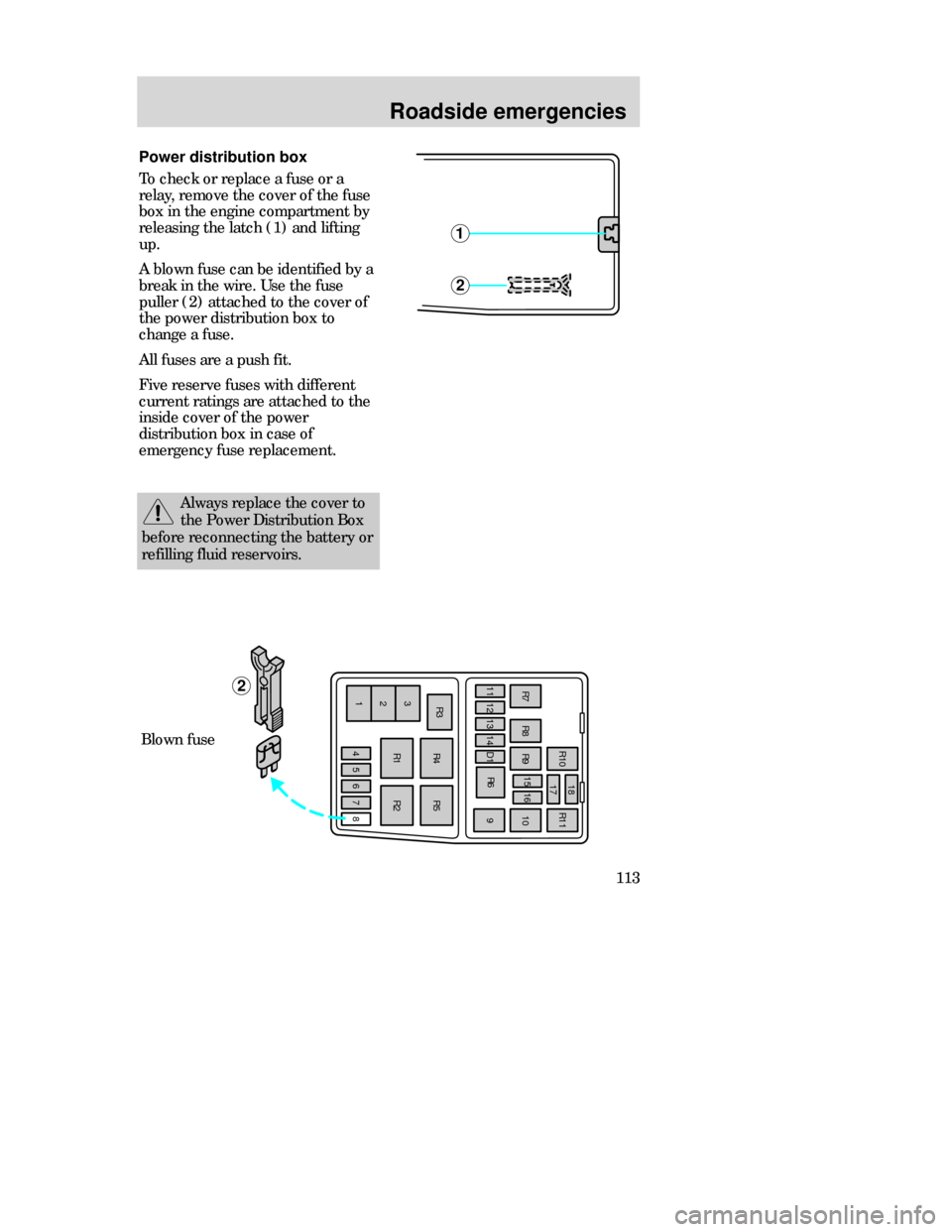
Roadside emergencies
113
1
2
2
R10
R91516R11
10 18
17
R8 R7
11121314R6
R4 R3
3
2
1R1R2 R5 D1
456789
Power distribution box
To check or replace a fuse or a
relay, remove the cover of the fuse
box in the engine compartment by
releasing the latch (1) and lifting
up.
A blown fuse can be identified by a
break in the wire. Use the fuse
puller (2) attached to the cover of
the power distribution box to
change a fuse.
All fuses are a push fit.
Five reserve fuses with different
current ratings are attached to the
inside cover of the power
distribution box in case of
emergency fuse replacement.
Blown fuse
Always replace the cover to
the Power Distribution Box
before reconnecting the battery or
refilling fluid reservoirs.
CDW IVC1-6Roads en C 5/15/97 8:53 PM Page 113
Page 115 of 200
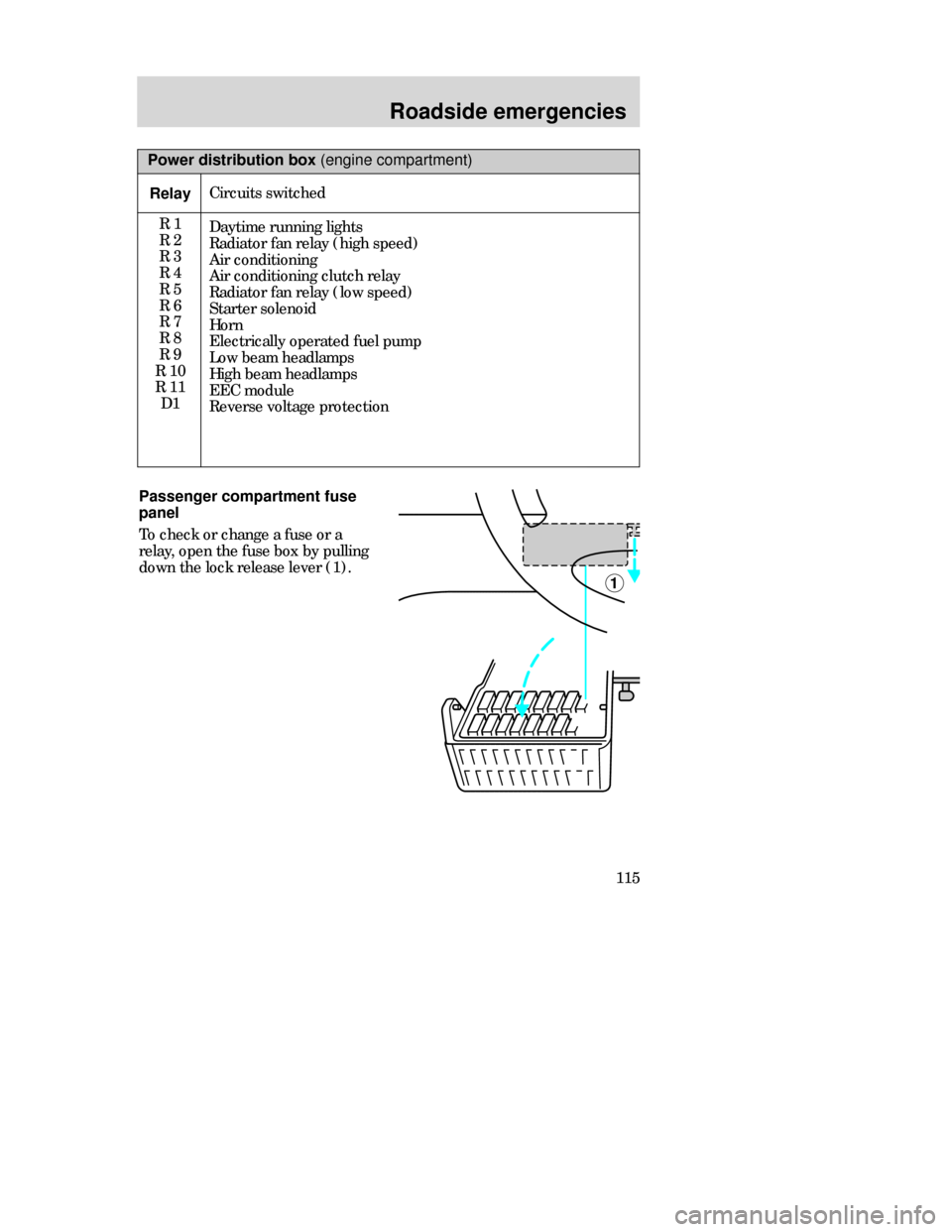
Roadside emergencies
115
Power distribution box (engine compartment)
RelayCircuits switched
R 1
R 2
R 3
R 4
R 5
R 6
R 7
R 8
R 9
R 10
R 11
D1
Passenger compartment fuse
panel
To check or change a fuse or a
relay, open the fuse box by pulling
down the lock release lever (1).
1
Daytime running lights
Radiator fan relay (high speed)
Air conditioning
Air conditioning clutch relay
Radiator fan relay (low speed)
Starter solenoid
Horn
Electrically operated fuel pump
Low beam headlamps
High beam headlamps
EEC module
Reverse voltage protection
CDW IVC1-6Roads en C 5/15/97 8:53 PM Page 115
Page 128 of 200
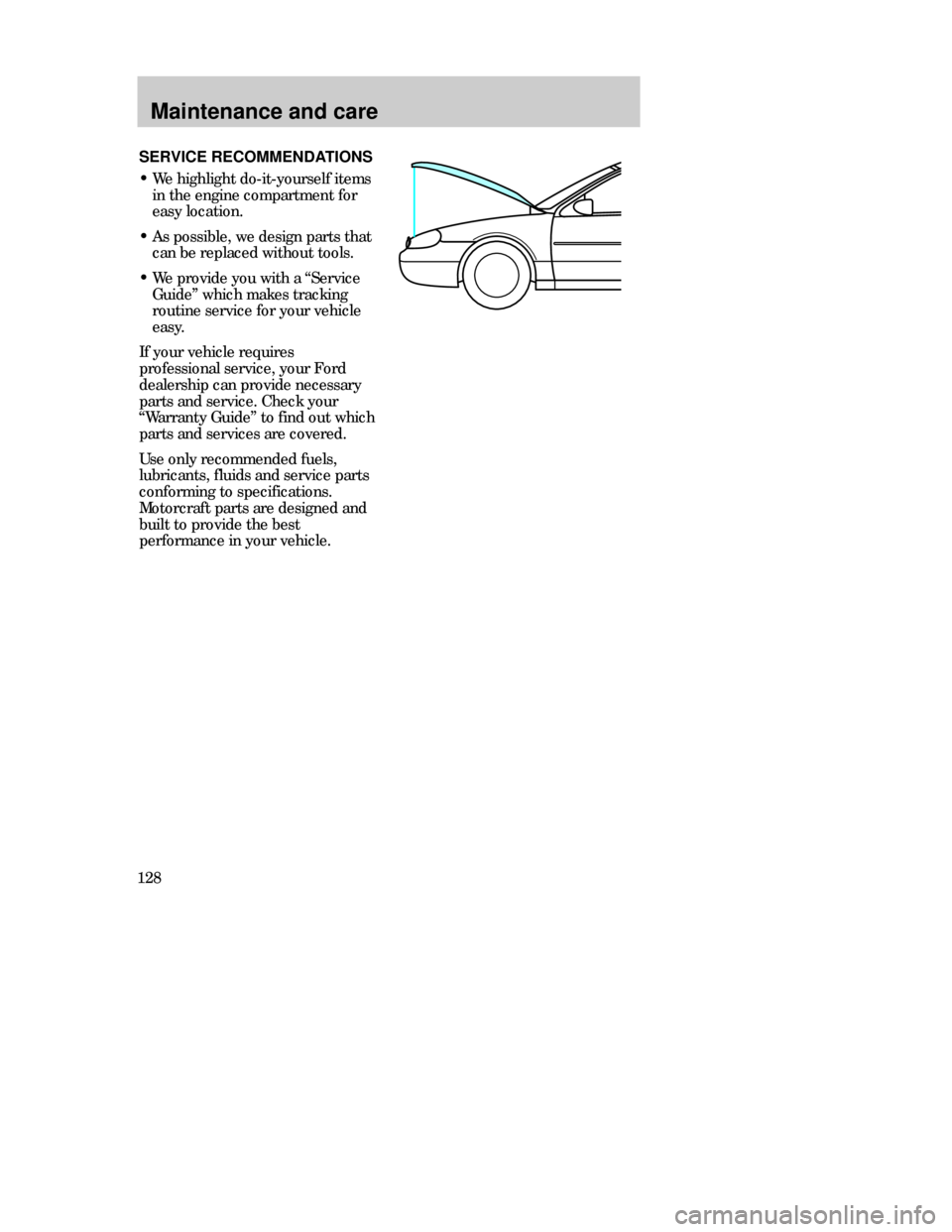
Maintenance and care
128SERVICE RECOMMENDATIONS
•We highlight do-it-yourself items
in the engine compartment for
easy location.
•As possible, we design parts that
can be replaced without tools.
•We provide you with a “Service
Guide” which makes tracking
routine service for your vehicle
easy.
If your vehicle requires
professional service, your Ford
dealership can provide necessary
parts and service. Check your
“Warranty Guide” to find out which
parts and services are covered.
Use only recommended fuels,
lubricants, fluids and service parts
conforming to specifications.
Motorcraft parts are designed and
built to provide the best
performance in your vehicle.
CDW VA1-19Maint en C 5/15/97 8:55 PM Page 128
Page 132 of 200
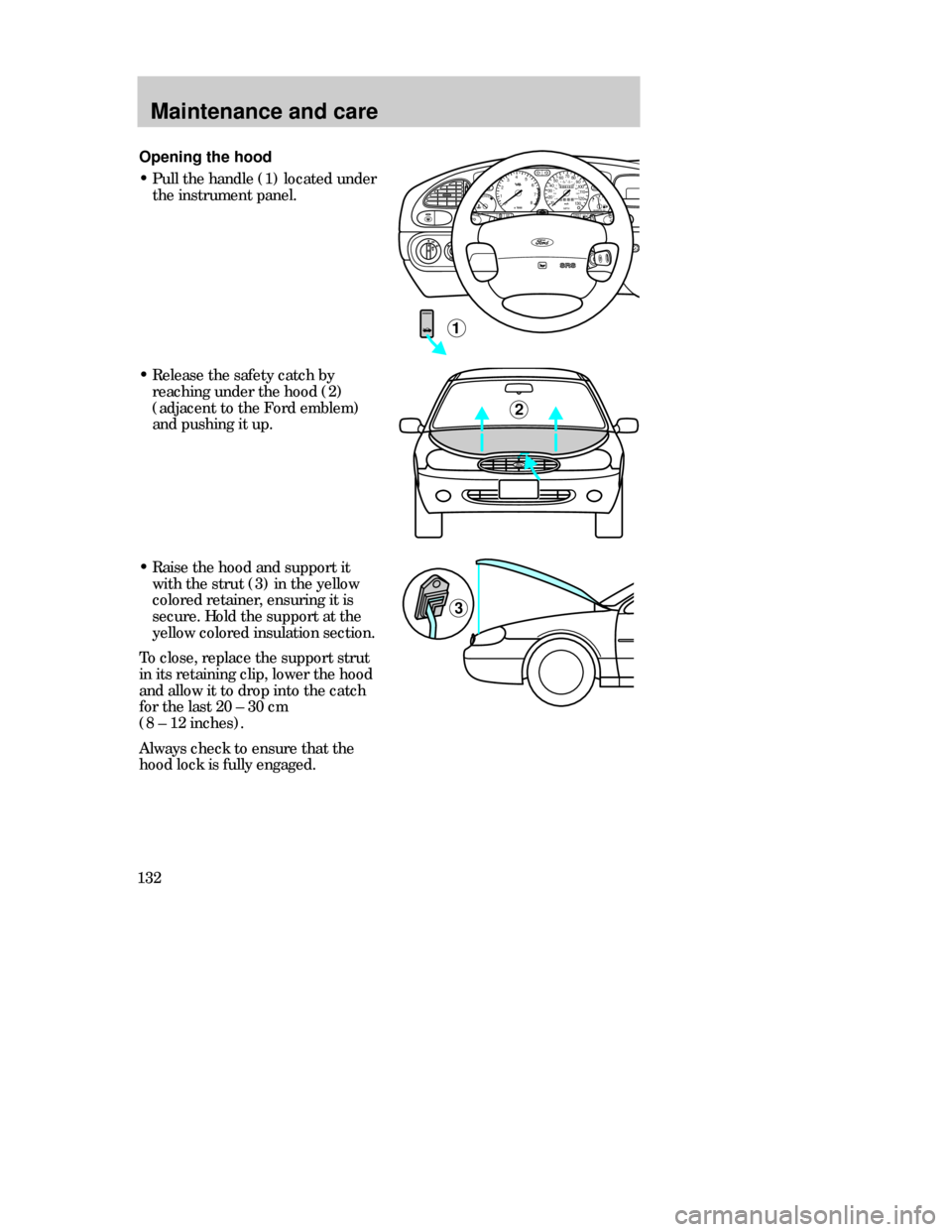
Maintenance and care
132Opening the hood
•Pull the handle (1) located under
the instrument panel.
000123000010 20 3040506070
80
90
100
110
120
130MPH20 406055
80120 100
140
160
180
200EF 1
/
2UNLEADED FUEL ONLY12
03x 1000
4
5
6
7
8
NORMALBRAKE
CHECK
ENGINE TRACTION
CONTROLO/D
OFF
MIRRORS
1
•Release the safety catch by
reaching under the hood (2)
(adjacent to the Ford emblem)
and pushing it up.
2
3
•Raise the hood and support it
with the strut (3) in the yellow
colored retainer, ensuring it is
secure. Hold the support at the
yellow colored insulation section.
To close, replace the support strut
in its retaining clip, lower the hood
and allow it to drop into the catch
for the last 20 – 30 cm
(8 – 12 inches).
Always check to ensure that the
hood lock is fully engaged.
CDW VA1-19Maint en C 5/15/97 8:56 PM Page 132
Page 135 of 200
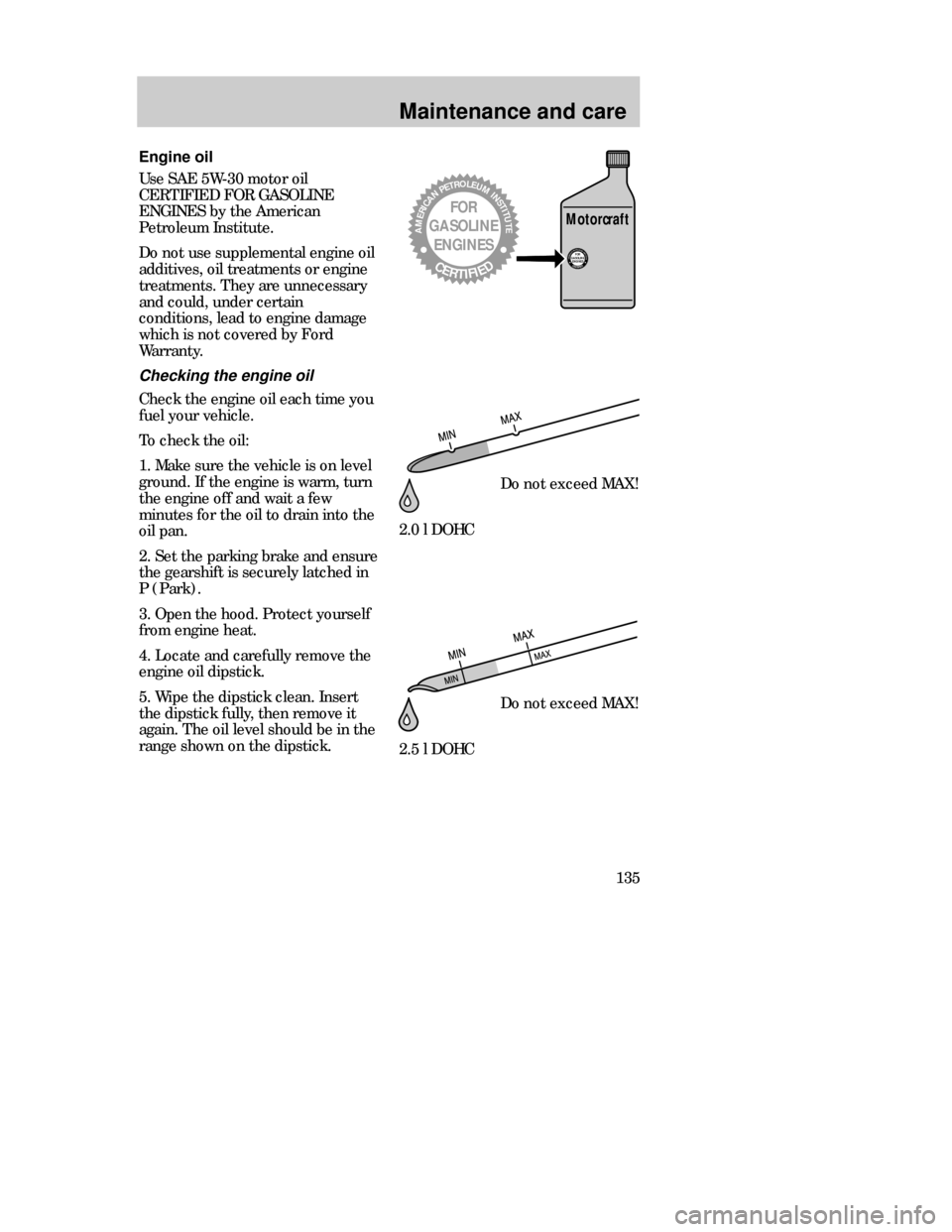
Maintenance and care
135
Engine oil
Use SAE 5W-30 motor oil
CERTIFIED FOR GASOLINE
ENGINES by the American
Petroleum Institute.
Do not use supplemental engine oil
additives, oil treatments or engine
treatments. They are unnecessary
and could, under certain
conditions, lead to engine damage
which is not covered by Ford
Warranty.
Checking the engine oil
Check the engine oil each time you
fuel your vehicle.
To check the oil:
1. Make sure the vehicle is on level
ground. If the engine is warm, turn
the engine off and wait a few
minutes for the oil to drain into the
oil pan.
2. Set the parking brake and ensure
the gearshift is securely latched in
P (Park).
3. Open the hood. Protect yourself
from engine heat.
4. Locate and carefully remove the
engine oil dipstick.
5. Wipe the dipstick clean. Insert
the dipstick fully, then remove it
again. The oil level should be in the
range shown on the dipstick.2.0 l DOHC
2.5 l DOHC
AMERICANPETROLEUMINSTITUTE
CERTIFIED
FOR
GASOLINE
ENGINES
AMERICANPETROLEUMINSTITUTECERTIFIEDFOR
GASOLINE
ENGINES
Motorcraft
Do not exceed MAX!
Do not exceed MAX!
CDW VA1-19Maint en C 5/15/97 8:56 PM Page 135
Page 136 of 200
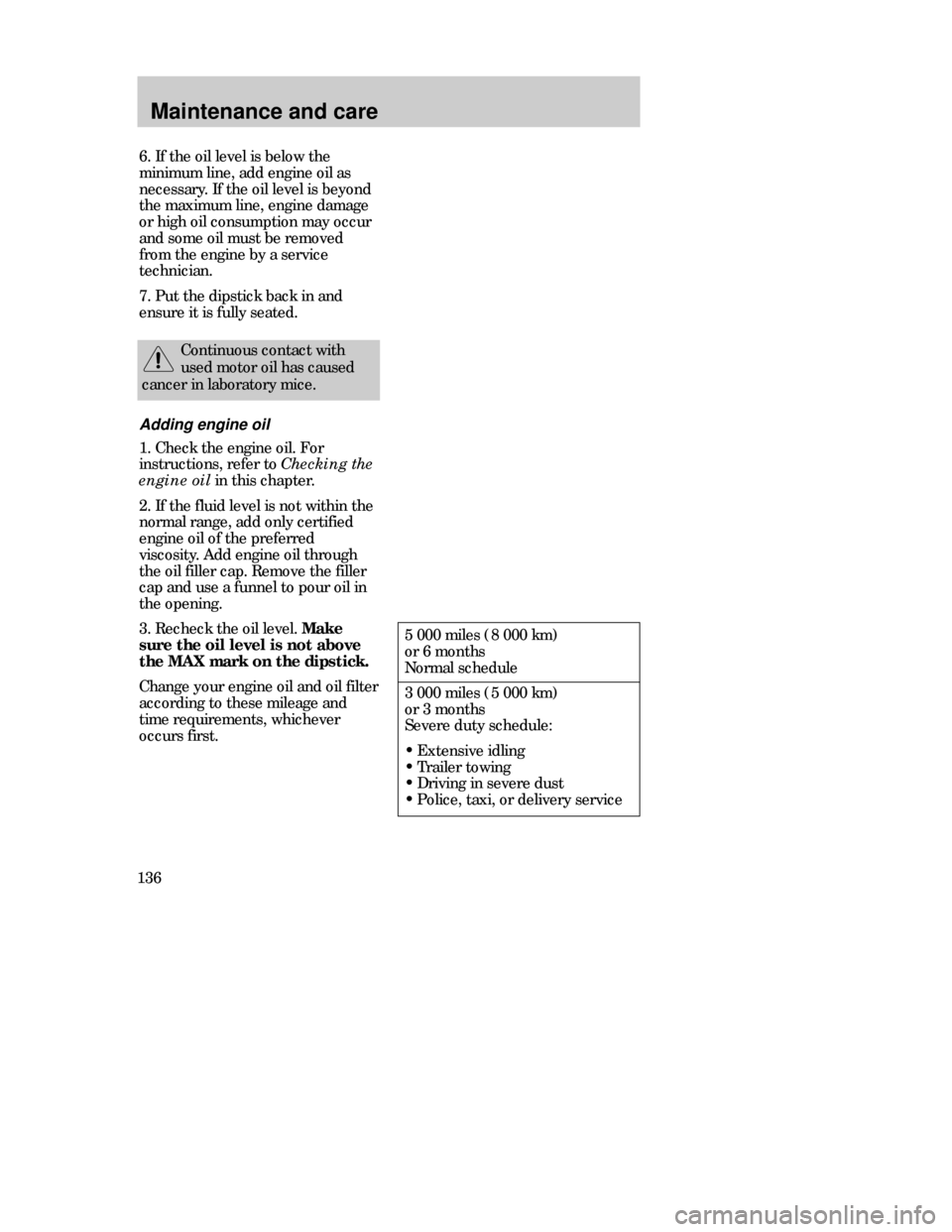
Maintenance and care
1366. If the oil level is below the
minimum line, add engine oil as
necessary. If the oil level is beyond
the maximum line, engine damage
or high oil consumption may occur
and some oil must be removed
from the engine by a service
technician.
7. Put the dipstick back in and
ensure it is fully seated.
Continuous contact with
used motor oil has caused
cancer in laboratory mice.
Adding engine oil
1. Check the engine oil. For
instructions, refer to Checking the
engine oilin this chapter.
2. If the fluid level is not within the
normal range, add only certified
engine oil of the preferred
viscosity. Add engine oil through
the oil filler cap. Remove the filler
cap and use a funnel to pour oil in
the opening.
3. Recheck the oil level.
Make
sure the oil level is not above
the MAX mark on the dipstick.
Change your engine oil and oil filter
according to these mileage and
time requirements, whichever
occurs first.5 000 miles (8 000 km)
or 6 months
Normal schedule
3 000 miles (5 000 km)
or 3 months
Severe duty schedule:
•Extensive idling
•Trailer towing
•Driving in severe dust
•Police, taxi, or delivery service
CDW VA1-19Maint en C 5/15/97 8:56 PM Page 136